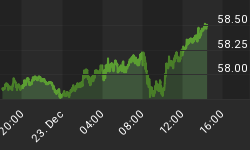In the last few weeks, Wall Street has been spooked by a technical occurrence know as the Hindenburg Omen. The basis for the concern is we have recently seen both relatively high numbers of new 52-week highs and new 52-week lows. Wikipedia has a good summary of the Hindenburg Omen calculations.
The recent triggering of the omen is concerning and aligns well with our models in that it is indicative of a weak stock market. However, comments and data about the omen seem to do a good job covering the "bad" outcomes after the omen was triggered, but give little performance data for stocks when "good" outcomes occurred following a Hindenburg sighting.
In a very well researched article on the Hindenburg Omen by Robert McHugh, he states the following:
There is a 30 percent probability that a stock market crash -- the big one -- will occur after we get a confirmed (more than one in a cluster) Hindenburg Omen. There is a 40.8 percent probability that at least a panic sell-off will occur. There is a 55.6 percent probability that a sharp decline greater than 8.0% will occur, and there is a 77.8 percent probability that a stock market decline of at least 5 percent will occur.
McHugh does a good job covering the "bad" above. Here is the same data presented from the "good" perspective:
There is a 70 percent probability that a stock market crash -- the big one -- will NOT occur after we get a confirmed (more than one in a cluster) Hindenburg Omen. There is a 59.2 percent probability that at least a panic sell-off will NOT occur. There is a 44.4 percent probability that a sharp decline greater than 8.0% will NOT occur, and there is a 22.2 percent probability that a stock market decline of at least 5 percent will NOT occur.
The first Hindenburg trigger came on August 12, 2010 when the S&P 500 closed at 1,083,61. Since then stocks have already dropped 4.04% using yesterday's intraday low of 1,039,83. Therefore, some pressure on the markets has already been relieved from a basic technical perspective.
A more balanced view of both the "bad" and "good" outcomes was presented by Mark Hulbert in How Bearish is the Hindenburg Omen? Below are some excerpts:
That's the urgent warning coming from devotees of an esoteric market timing gauge known as the Hindenburg Omen. They say that it is a reliable indicator of an imminent stock market crash. But I'm not so sure. In fact, my review of the data suggests that those using the Omen to predict a crash are good candidates to win the Chicken Little award... Upon closer scrutiny, the Omen's triggering earlier this month turns out to be not very scary at all.
At CCM, our models flashed some warning signals on August 11, 2010 as described in the post Odds of a Multi-Week Correction Have Increased. Like the followers of the Hindenburg Omen, we have been and continue to be concerned about the current market environment. We believe the markets need to be monitored very closely in the coming days and weeks.
Taking into account the S&P 500's recent slide from 1,129, from a historical standpoint (1980-2010), the markets risk-reward profile is indicating some patience is now in order. We respect the risk-reward profile could deteriorate from current levels, but at present it favors bullish outcomes over bearish outcomes. The markets have been and remain fragile, so our bullish bias here is tentative and subject to change if the CCM BMSI drops below -165 (see table below). The August 25th BMSI level was 278 leaving us with a positive bias for the time being.

According to the Wall Street Journal, significant stock market declines have followed Hindenburg Omens only 25% of the time. Said another way, 75% of the time significant stock market declines did NOT follow a triggering of the Hindenburg Omen. There are plenty of technical and fundamental reasons to be concerned in the current environment, but the Hindenburg Omen seems to be getting a little too much hype relative to the statistical realities associated with it.















